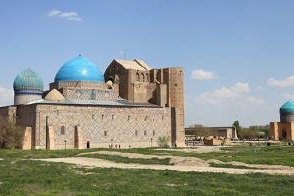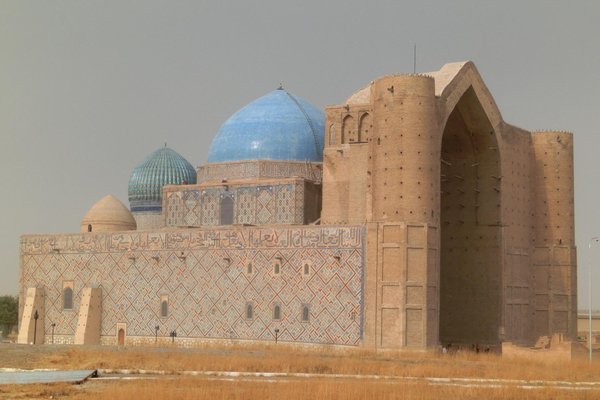Kazakhstan
Mausoleum of Khoja Ahmed Yasawi
The mausoleum of Khoja Ahmed Yasawi is an influential Islamic religious monument built in the Timurid architectural style.
Khodja Ahmed Yasawi was a prominent Sufi poet and philosopher. In the 12th century, he was buried in a small mausoleum that attracted many pilgrims. It was Timur who erected the current immense mausoleum over his burial vault in the late 14th century. The design (conical domes, decoration such as muqarnas and glazed tiles) became a model for other major buildings of the Timurid period. The mausoleum is a multi-purpose structure, as it also serves as a mosque.
Community Perspective: of an impressive size, this is one of the highlights in Central Asia. Juha describes visiting by public transport, Clyde advises revisiting at different times of the day and Solivagant tackles the place of religion in contemporary Kazakhstan and how the UNESCO site has been defined and presented.
Site Info
Official Information
- Full Name
- Mausoleum of Khoja Ahmed Yasawi (ID: 1103)
- Country
- Kazakhstan
- Status
-
Inscribed 2003
Site history
History of Mausoleum of Khoja Ahmed Yasawi
- 2003: Inscribed
- Inscribed
- Type
- Cultural
- Criteria
- i
- iii
- iv
Links
- UNESCO
- whc.unesco.org
- Official
-
- azretsultan.kz — State Historical and Cultural Reserve Museum Azret Sultan
- kazakhstan.travel — Kazakhstan .travel
- Related
-
- natcom.unesco.kz — Link
- natcom.unesco.kz — Link
All Links
UNESCO.org
- whc.unesco.org — whc.unesco.org/
Official Website
- azretsultan.kz — State Historical and Cultural Reserve Museum Azret Sultan
- kazakhstan.travel — Kazakhstan .travel
Related Resources
- natcom.unesco.kz — Link
- natcom.unesco.kz — Link
News Article
- June 10, 2024 astanatimes.com — Experts Warn of Growing Threat to Khoja Ahmed Yassawi Mausoleum
Community Information
- Community Category
- Religious structure: Islamic
Travel Information
Recent Connections
-
Named after individual people
Khodja Ahmed Yasawi is the most promine… -
Libraries
a library (Kitab khana) (AB ev) -
Built in the 14th century
commissioned in 1389
Connections of Mausoleum of Khoja Ahmed Yasawi
- Individual People
-
-
Timur
"The Mausoleum was built at the end of the 14th century by the order of Timur" (AB ev)
-
- Trivia
-
-
On Banknotes
Kazakhstan; 500 Tenge; 1999
-
- History
-
-
Silk Roads
(Near) Classic Land Route; in ICOMOS thematic study but no details on role or function. -
Located in a Former Capital
Located in Turkestan which is assumed to have been Beitan, Capital of Kangju 250 BC-300
-
- Architecture
-
-
Domes
18.2m, largestever built in Central Asia 1389 -
Timurid Architecture
"an outstanding achievement in the Timurid architecture" (OUV) -
Square Kufic
See www.kufic.info
-
Glazed tiles
"its extrados is covered with green and golden decorated tiles" (AB ev) -
Muqarnas
The intrados of the domes is decorated in alabaster stalactites (muqarnas). (AB ev)
-
- World Heritage Process
-
-
Single Monuments
"In terms of the categories of cultural property set out in Article 1 of the 1972 World Heritage Convention, this is an architectural monument." (AB ev). Also meets criterion i: masterpiece of human creative genius. -
Perfect Inscriptions
2003 -
First inscriptions
Kazakhstan 2003
-
- Religion and Belief
-
-
Notable mosques
"The building has spaces assigned for several functions: such as .. a mosque" (AB ev) -
Sufism
Khodja Ahmed Yasawi is the most prominent religious figure in the history of Sufism
-
- Constructions
-
-
Mausolea
"The nominated property is limited to the mausoleum of Ahmed Yasawi" (AB ev) -
Unfinished constructions
"The building remained unfinished at the death of Timur in 1405, and was never completed. Therefore, the main entrance still lacks the surface finish and the two minarets that were planned." (AB ev)
-
- WHS on Other Lists
-
-
Memory of the World
Collection of the manuscripts of Khoja Ahmed Yasawi (2003)
-
- Timeline
-
-
Built in the 14th century
commissioned in 1389
-
- Science and Technology
-
-
Libraries
a library (Kitab khana) (AB ev)
-
- WHS Names
-
-
Named after individual people
Khodja Ahmed Yasawi is the most prominent religious figure in the history of Sufism.
-
News
- astanatimes.com 06/10/2024
- Experts Warn of Growing Threat to …
Recent Visitors
Visitors of Mausoleum of Khoja Ahmed Yasawi
- Alejandro Lau
- A. Mehmet Haksever
- Ana
- Ask Gudmundsen
- Aspasia
- Atila Ege
- BaziFettehenne
- Bin
- Cheryl
- Clyde
- CugelVance
- David Marton
- Dimitar Krastev
- Els Slots
- Erik Jelinek
- Fan Yibo
- Feldhase
- Fernweh
- finsbury_jo
- George Gdanski
- Gernot
- henryjiao18
- hotpickle
- Iain Jackson
- Ivan Rucek
- Jakubmarin
- Janos
- Jarek Pokrzywnicki
- Jawnbeary
- Jean Lecaillon
- Jonas Kremer
- Juha Sjoeblom
- KarenBMoore
- Kasper
- Kevin McFarland
- Knut
- Lado Joel
- Luis Filipe Gaspar
- Luke LOU
- Maciej Gil
- Malgorzata Kopczynska
- Marcobrey
- Martin
- Mathijs
- Mihai Dascalu
- Mikko
- Milan Jirasek
- Miloš Tašković
- Naim Y
- Nihal Ege
- Paul Schofield
- Remski
- Reza
- Roman Bruehwiler
- Sergio Arjona
- Sesito71
- Solivagant
- Stanislaw Warwas
- StaziG
- Szucs Tamas
- Tamara Ratz
- Thomas Buechler
- TimPick
- Westwards
- Xiquinho Silva
- Yevhen Ivanovych
- zfish
- Zoë Sheng
Community Reviews
Show full reviews
I visited this WHS in June 2017. This site is the main reason I included Kazakhstan on my Uzbekistan-Turkmenistan trip and I'm glad I spent 2 nights in Turkestan as the mausoleum didn't disappoint.
Even after having visited Uzbekistan's Timurid monuments, this mausoleum still ranks as one of the most grandiose and best-preserved in the region. The mausoleum alone can be visited in less than an hour but it would be a great pity not to revisit at different times of the day (if you're lucky enough to visit on a sunny day) to view the intricate geometric designs and turquoise and blue tiles with the best light conditions.
Moreover, most of the pilgrims visit just after sunrise or just before sunset and go round the main building touching the walls and stopping every now and then to pray. Even though entrance to the mausoleum and all the other buildings is from 9am till 6pm, the whole complex exterior can be visited freely at any time of the day. The fact that it is still an active pilgrimage site adds to the whole experience in my opinion. In the morning the best lighting is on the reconstructed fortification walls and main entrance gate, while in the later afternoon, the best lighting is on the rear part of the mausoleum and its domes.
There are UNESCO signs all over the place even in front of buildings which have nothing to do with the inscription. However, there is a simple makeshift sign …
Keep reading 0 comments
Beyond the value of the building itself there were 2 aspects of our visit to the Mausoleum of Khoja Ahmed Yasawi in May 2017 which we found of interest – first, the extra insight and impetus it gave us for understanding the developing place of religion in contemporary Kazakhstan (a theme we followed throughout our tour of the country) and second, the way in which the UNESCO site had been defined and presented. First the building itself and the logistics.
The Mausoleum dominates the town of Turkistan - we drove up from Shymkent in the morning, stopping off at the T List site of Otrar and the Arystan Bab Mausoleum (another nearby pilgrimage site) for an hour or so on the way, had lunch in Turkistan, gave the mausoleum and the surrounding area a bit over 2 hours and then drove on to Aksu-Zhabagly, by-passing Shymkent on the way back by following the main highway. The mausoleum is set in the centre of what was once the old city of Turkistan and is the only extant original structure from the city’s pre-Russian era. Various buildings nearby and a part of the walls have however been recently reconstructed but, around the Mausoleum and within the boundaries of the old city, lies a vast archaeological zone of decaying mud walls of ruined buildings and abandoned “digs”. The nearby museum was once a barracks and was constructed by the Russians from bricks ransacked from another of the tombs inside the perimeter. The …
Keep reading 0 comments
Site visited April 2014. The grandiose Timurid era mausoleum of Khoja Ahmed Yasawi is the highlight of Kazakhstan and also one of the highlights in Central Asia.
I flew from Almaty to Shymkent which is the usual hub for visiting the town of Turkestan. From my hotel I took a bus to Shymkent central bazaar where I changed to marshrutka. The journey to Turkestan lasted three hours. At Turkestan bus station I took a taxi to the site. It was a sunny and warm spring day and the site was full of local people.
The mausoleum is very impressive and you really feel yourself dwarfed by its sheer size. Especially the entrance portal is huge. It is easy to notice that the front facade is unfinished. There are lots of birds nesting in the holes of entrance portal. Backside of the mausoleum and the domes have flawless and brightly colored tiling. The other side of the mausoleum is surrounded by thick walls. Around the mausoleum there is an archaeological site where you can visit several smaller buildings.
While the exterior of the mausoleum is detailed and colourful, the interior is very plain, simple and white. There are lots of rooms which contain various valuable objects. Photography is not allowed inside but I remember that it was so packed full of people that I just walked with the flow from room to room.
It is interesting that according to this website’s statistics this is one of the least visited World Heritage …
Keep reading 0 comments
Anyone who visits the mausloeum fells dwarfed by the magnificence of the building and the atmoshpere of spirituality which pervades the structure. When I visited the site entrance was free.If you are in the city of Turkestan you will not have problem finding the mausoleum ,because all taxi drivers, actually everyone knows where it is.Once you are there, you should defninitely go inside and visit all the chambers including the burial-vault, which is preceded by wonderfully carved doors. Be sure to visit the chamber with a well. Khoja Ahmed Yasawi spent last years of his life in this well, because he didn't want to live longer than the Prophet.
Keep reading 0 comments
